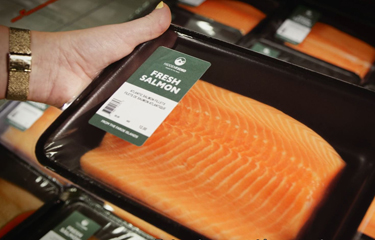Hiddenfjord CEO Atli Gregersen challenges industry to reduce CO2 impact

Gøta, Faroe Islands-based salmon-farming firm Hiddenfjord is celebrating the one-year anniversary of ceasing its use of air freight to transport its fish, with a subsequent reduction of CO2 emissions by 94 percent.
Hiddenfjord CEO Atli Gregersen said he was inspired to take action following a talk about climate change by Boomtown Rats singer and political activist Bob Geldof at a conference in the Faroes.
“Geldof said that if you act instead of just thinking about doing something, then it will happen. You just need to make the decision, then the ‘if’ becomes ‘what do I do now to achieve my goal,’ and suddenly you are thinking differently,” Gregersen told SeafoodSource.
The decision was one of the easiest to make in terms of environmental benefits, but one of the hardest in terms of economics, Gregersen said.
“As a family-owned company, we are able to think about what is important, rather than being driven by a need to satisfy investor balance sheets. We have long been driven by a desire to produce a truly sustainable product and had already begun to reduce our carbon footprint by sending salmon to Europe and Russia via sea transport. However, it seemed impossible to reach distant markets such as the U.S.A. and China without using air freight,” Gregersen said. “We were concerned that if we stopped flying fresh fish to the Chinese and American markets, which are the most lucrative, then this would lead to a short-term financial crisis for the company. However, we picked a date, 10 October, 2020, then figured out how to make it work.”
A further impetus for Hiddenfjord’s move was the publication of a report on the greenhouse gas emissions of Norwegian seafood products by European research institute SINTEF. The report revealed air freight emits around 50 times as much CO2 as sea freight, and recommended finding alternative methods of transport for any products that could feasibly be moved by sea instead of air. Gregersen challenged the rest of the salmon industry to follow suit, especially in response to the 14 October release of the Climate Transparency Report – the annual overview of G20 climate action – which revealed that carbon emissions are once again on the rise, following a dip during global COVID-19 lockdowns. The G20 countries account for 75 percent of the world’s carbon emissions.
“We worked out that our salmon has a CO2 footprint of five kilograms per kilo of finished product, when iced, boxed, and ready to leave the factory, but flying it to the U.S.A adds a further seven kilograms of CO2 to the footprint, while a flight to China adds around 15 kilograms more CO2 per kilo of salmon,” Gregersen said. “This simply was not acceptable to us, and we figured that salmon are meant to swim, not to fly.”
Gregersen said his company’s transportation transition has been aided by the good reputation of its “Raised in the Wild” salmon, grown in open-sea pens in exposed, high-current areas of the Faroes. But before switching over entirely to sea shipments, he said the company pushed hard to perfect its quality control and processing techniques.
“We knew that the quality of the salmon had to be spot-on before it left the processing unit, so we started to rethink our harvesting, cleaning, chilling, and packing techniques to see how we could improve the shelf-life,” he said. “The fish is now packaged on ice just three hours after stress-free harvesting, sealed into chilled containers in the factory, and remains in an unbroken, regulated cool chain until it reaches our customers in perfect condition in more than a dozen countries worldwide.”
Despite the preparations, Hiddenfjord’s first trial of sea-freighting its salmon to the U.S. did not go as expected. The first container was routed through a U.K. port that was not accustomed to fast-tracking chilled containers, and then salmon arrived in New York just as the pandemic hit and the city went into lockdown.
“We still managed to sell some of that shipment, and it gave us hope that we were on the right track,” Gregersen said. “The answer was to switch to shipping out of Iceland and docking in Portland, [Maine], a journey of nine days, and this is working very well.”
Gregersen said there had been concerns that some of the fish is more than two weeks old by the time it reaches customers, but a recent blind sampling conducted with 100 U.S. consumers testing salmon shipped by air and sea found both rated equally favorable in terms of taste, texture, and aroma.
Sales to the United States are now increasing month on month and currently account for 40 percent of Hiddenfjord’s volume, according to Gregersen.
In tandem with developing the market for sea-freight fresh salmon, the company has also been trialing shipments of frozen salmon to China, which are refreshed close to market and sold as a chilled product.
“Both freezing and refreshing technology have developed considerably over the past few years, and we believe that this represents the future of selling high-quality salmon fillet anywhere in the world, to compete with fresh salmon. Trials have gone well so far, and it is a great product for sushi and sashimi, but there is still a way to go to overcome consumer perceptions that refreshed salmon is as good as fresh, especially in the Asian market,” Gregersen said. “Just watch this space!”
Photo courtesy of Hiddenfjord





Share